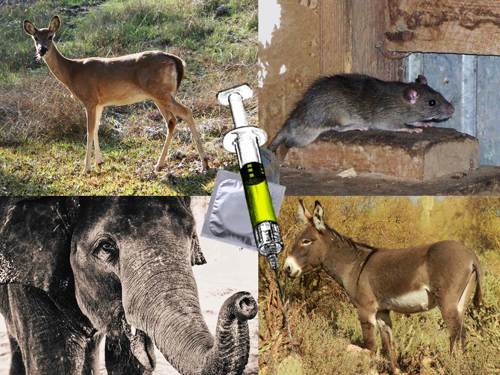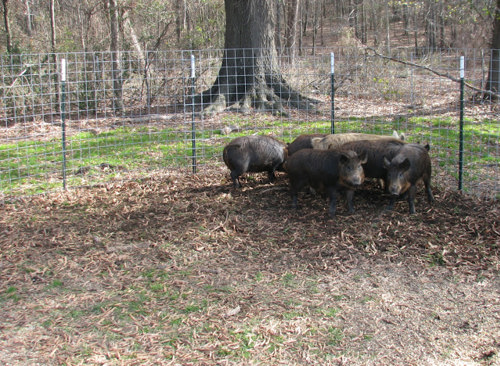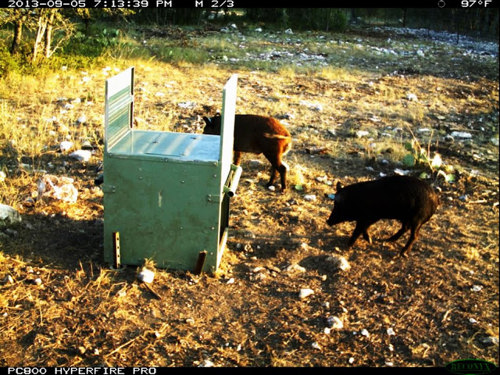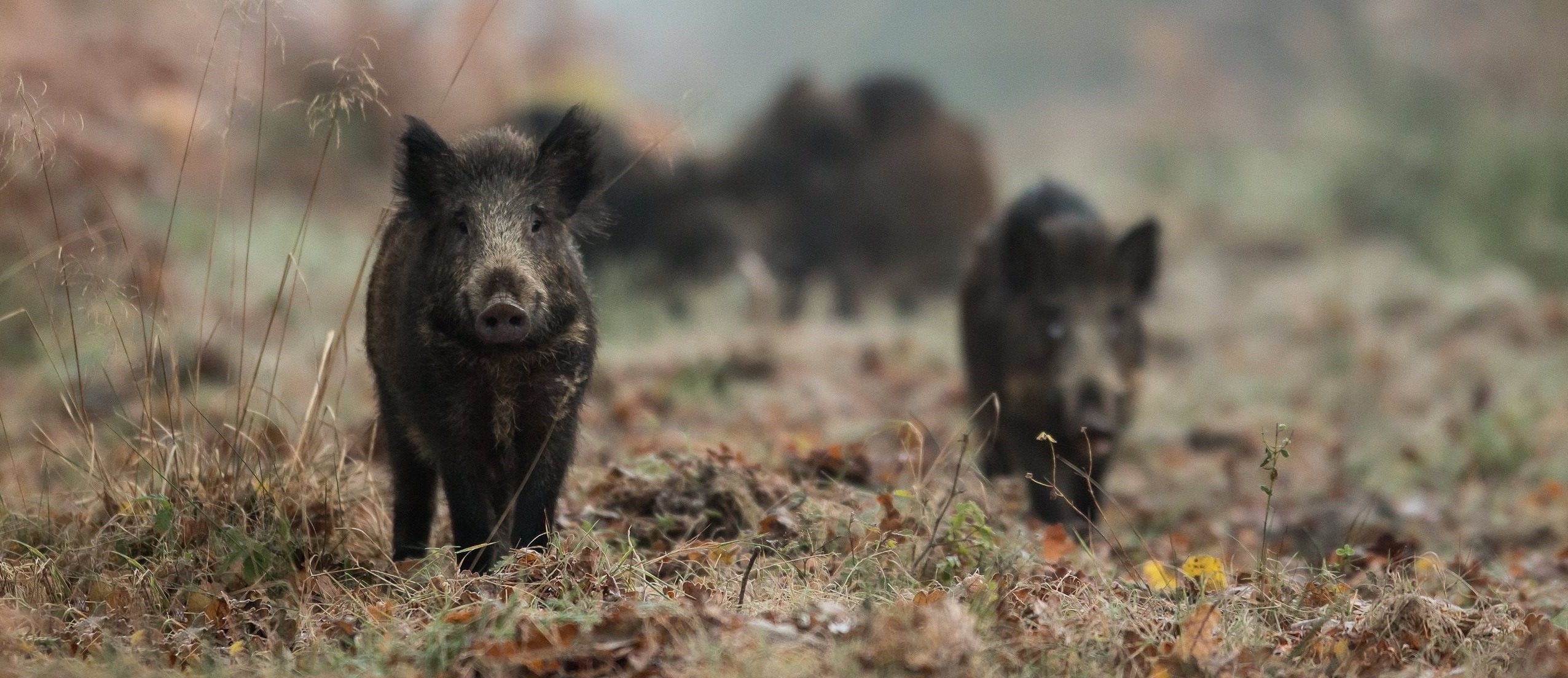An Evaluation of Contraceptive Viability in Wild Pig Management
Contraception, or “birth control,” has long been suggested as a potential means of controlling wild pig (Sus scrofa) populations. While there are currently no pharmaceuticals labeled for use on wild pigs in Texas, the continued expansion of wild pig populations in the Lone Star State has many Texans again questioning the viability of wild pig contraception. Given the prolific fecundity of these animals, the idea of contraception admittedly does make sense. But what does the research tell us about the feasibility of this technique? This article will highlight research that has been conducted on wildlife fertility control, and will also discuss challenges that could potentially limit the success of this alternative within free-ranging populations of wild pigs.
General Contraceptive Use in Wildlife Species
Contraception has been administered worldwide as a tool for fertility control in a variety of wildlife species including mice, rats, donkeys, wild horses, elephants, deer and others.3,8,12,14 Common types of contraceptives include both steroid-based and immunocontraceptives. While commonly used in humans, steroid-based contraception is widely considered as impractical for wildlife.1,2 Early efforts at wildlife contraception conducted in the late 1980’s encountered significant issues including prolonged estrus cycles in females, animal aggression, diminished efficacy over time, animal toxicity, passage through the food chain and others.7 Subsequent wildlife vaccines have since improved considerably, and today are administered to wildlife species within protected nature preserves, urban areas, and other locations where conventional control techniques are either not feasible or legal.

Wildlife contraceptives have been successfully given to species including deer, mice, elephants, donkeys and others. However, physical control of the animal and repeated dosing/boosters are required in order to be effective.
The research cited above documenting contraceptive use in wildlife species share several conditional factors in common. First, contraceptives were administered directly and through a vaccine – not remotely or through oral uptake (consumption). Second, contraceptives were generally given within controlled environments and not in free ranging habitats. Finally, vaccines were administered under the assumption that contracepted species would not be intended for human consumption. With these commonalities in mind, let’s consider the feasibility and potential impacts of administering an immunocontraceptive to free-ranging exotic invasive feral swine.
Feasibility of Wild Pig Contraception
In order to administer an intramuscular (IM) contraceptive vaccine to a wild pig, one must first gain physical control of the animal. Now to many this goes without saying, but if a person goes through all the trouble of pre-baiting, patterning and trapping a wild pig why on earth would they let that animal go? No matter how effective any contraceptive is, at least one much easier and less expensive option exists that will solve the problem just the same. And therein lies a significant problem – the only feasible delivery of a contraceptive to free-ranging wild pigs would be through remote oral uptake. Put simply, this means that the pigs would need to physically consume the “birth control” while in the wild. And if administered through consumption, a number of challenges are inherited including many of the same concerns associated with the use of toxicants.

Wild pigs would likely need to be trapped and sedated before an IM contraceptive vaccine could be administered. (Image Credit Dr.Billy Higginbotham)
Challenges to Fertility Control in Free Ranging Wild Pigs
Research showed that efficacy of various wildlife fertility control agents can vary dramatically by type as well as by wildlife species.5-8 Population modeling indicated that 66% of the Texas wild pig population would need to be removed annually in order to begin to reduce populations.13 Based on this research, we can assume that an ideal wild pig immunocontraceptive would have a minimum efficacy of at least 66%, provided it were administered to the entire breeding population. Treating an entire population of millions of wild pigs even once would in itself be a major undertaking. However, this challenge is compounded by the fact that there are currently no wildlife immunocontraceptives that do not require multiple initial and/or subsequent periodic inoculations in order to be effective. Research conducted on long term wildlife immunocontraception has shown efficacy over several years, but in each case was obtained through an injectable vaccine that required physical control of the animal.5,6,14 Either a single dose immunocontraceptive would need to be extensively researched and synthesized, or wild pigs would need to be dosed periodically throughout their entire reproductive life span. Female wild pigs, or sows, are capable of reproduction as early as 6 months of age and have average lifespan of 8-12 years in the wild.9 Research has documented a single immunocontraceptive dose as costing as much as $50 or more,4 and there are currently an estimated minimum of 2.6 million wild pigs in Texas alone. Such expense as well as the near logistical impossibility of administering over a decade of treatments to millions of animals (with a product that doesn’t even exist) would represent a tremendous challenge.
Another significant challenge to remotely administered wild pig fertility control is species specific delivery. The drug would need to be encapsulated or otherwise provided in such a way that it is not only bait stable and palatable, but also accessible to only wild pigs. Researchers have already been working for many years to develop this exact type of system in order to deliver toxicants such as sodium nitrite to wild pigs. A number of different designs for wild pig specific baiting systems have been devised that utilize animal recognition software, rooter gates and various types of weighted doors. However, non-targeted species including raccoons and especially black bears have proven persistent in their ability to access baits intended only for wild pigs. Another compounding factor is that feral swine are highly intelligent and adaptable animals,10 and are capable of exhibiting aversion to man-made contraptions including box traps, corral traps, rooter gates and increasingly even helicopters.

Species specific delivery systems such as this one are designed to allow wild pigs to access baits without allowing access to non-targeted species.
Research has documented secondary transfer of wildlife contraceptives through the food chain, and wild pigs from Texas are popular table fare worldwide. Throughout the recent registration process of a warfarin-based toxicant in Texas, wildlife professionals, state officials and others observed significant political backlash from wild pig processing facilities, hunters and the general public. Unless a wild pig “birth control” were developed that was research proven to be completely incapable of secondary transfer, there would undoubtedly be considerable economic and political ramifications – not to mention a real threat to human health. Native predatory species including mountain lions, bobcats and others as well as federally protected carrion feeders such as black and turkey vultures could also potentially be impacted. Wild pigs cannot sweat and must occupy water sources in order to cool themselves, and secondary transfer could also potentially be actuated through any surface water system in which these animals routinely eliminate waste. And while bacteria such as E. coli can eventually be removed from water sources through conventional disinfection processes, many pharmaceuticals and pesticides either require special and expensive treatments or cannot be removed at all.
Conclusion
Wild pigs cause an estimated 1.5 billion dollars in agricultural damages in the United States each year.11 They destroy habitat, negatively impact native wildlife, degrade water quality, threaten livestock production and the list goes on. These animals are classified as the most reproductively successful large mammal worldwide, so developing a means to inhibit the reproductive capacity of this species does seem like a logical strategy. However, at this time the research simply does not support this means as a feasible alternative in wild pig management. There is no wildlife inoculation currently available which would meet the criteria necessary to be effective. Additional challenges of species specific delivery, repeated dosing, cost, wild pig intelligence, secondary transfer and others further reiterate wild pig fertility control as currently being impractical. There is most likely no one “silver bullet” that will solve the wild pig problem, but the reality is that researchers are much closer to developing a viable toxicant than an immunocontraceptive. In the meantime, conventional techniques and emerging technologies such as remote/suspended trapping systems coupled with a routine aerial gunning regimen remain among the best available strategies for abating the damages associated with wild pigs.
Wild pig resources listed below are available at the AgriLife Bookstore
Click here for additional resources on wild pigs
Literature Cited
1. Barlow, N.D. 2000. The ecological challenge of immunocontraception. Journal of Applied Ecology. 37: 897-902.
2. Cooper, D.W. and E. Larsen. 2006. Immunocontraception of mammalian wildlife: ecological and immunogenetic issues.Reproduction. 132:821-828.
3. Delsinka, A. K., J. J. van Altenab, D. Groblerb, H. J. Bertschingerc, J. F. Kirkpatrickd and R. Slotowa. 2007. Implementing immunocontraception in free-ranging African elephants at Makalali Conservancy. Journal of South African Veterinary Association. 78(1): 25–30.
4. Fagerstone, K. A., M. A. Coffey, P. D. Curtis, R. A. Dolbeer, G. J. Killian, L. A. Miller and L. M. Wilmot. 2002. Wildlife fertility control. Wildlife Society Technical Review. 2:2, 29 pp.
5. Fraker, M.A., R.G. Brown, G.E. Gaunt, J.A. Kerr and B. Pohajdak. 2002. Longlasting, single-dose immunocontraception in fallow deer in British Columbia. Journal of Wildlife Management. 66:1141–1147.
6. Gray, M.E., D.S. Thain, E.Z. Cameron and L.A. Miller. 2010. Multi-year fertility reduction in free-roaming feral horses with single-injection immunocontraceptive formulations. Wildlife Research. 37:475–481.
7. Kirkpatrick, J.F., R.O. Lyda and K.M. Frank. 2011. Contraceptive vaccines for wildlife: a review. American Journal of Reproductive Immunology. 66:40–50.
8. Locke, S.L., M.W. Cook, L.A. Harveson, D.S. Davis, R.R. Lopez , N.J. Silvy and M.A. Fraker. 2007. Effectiveness of Spayvac for reducing white-tailed deer fertility. Journal of Wildlife Diseases. 43(4):726-30.
9. Mapston, M. E. 2004. Feral hogs in Texas. Texas Cooperative Extension Service and USDA-APHIS-Wildlife Services. 26 pages.
10. Mungall, E.C. and W.J. Sheffield. 1994. Exotics on the range: the Texas example, part II. The New Animals. Texas A&M University Press, College Station. 67–73.
11. Pimental, D. 2007. Environmental and economic costs of vertebrate species invasions into the United States. Managing Vertebrate Invasive Species. Paper 38.
12. Shahiwala, A. and A. Misra. 2006. Preliminary investigation of the nasal delivery of liposomal leuprorelin acetate for contraception in rats. Journal of Pharmacy and Pharmacology. 58:19–26.
13. Timmons, J. B., B. Higginbotham, R. Lopez, J. C. Cathey, J. Mellish, J. Griffin, A. Sumrall and K. Skow. 2012. Feral hog population growth, density and harvest in Texas. Texas A&M Agrilife Extension Service SP-472.
14. Walden, C.M., T.D. Butters, R.A. Dwek, F.M. Platt and A.C. van der Spoel. 2006. Long-term non-hormonal male contraception in mice using N-butyldeoxynojirimycin. Human Reproduction. 21(5): 1309-1315.





